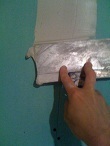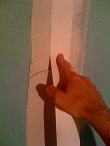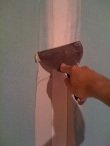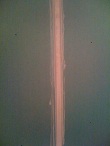
How to Tape Drywall
Taping drywall is the first step in floating and finishing drywall seams. The concept is simple yet the technique used is important for creating strong joints that do not crack. Follow the step by step guide below to effectively tape drywall seams. This process is used to tape seams with paper drywall tape. Fiber mesh tape requires a slightly different method.

Step 1
Using a six or eight inch drywall knife spread a thin even layer of drywall mud over the area where the two sheets of drywall meet. Ensure that the mud is directly over the seam and extends 1-½ inches on each side of the joint. Be careful not to leave bare spots. Not having enough mud behind the tape is the cause of drywall tape bubbling.

Step 2
Place a strip of drywall tape over the mud the entire length of the joint. Use caution to keep the tape centered directly over the joint. This may present a challenge since the mud is hiding the exact location of the seam. This is why it is important to ensure the mud is spread directly over the seam in step one. Cut the drywall tape by ripping it by hand or with the edge of your six inch drywall knife.

Step 3
Beginning in the center of the seam, work toward the ends of the paper. If you work from the ends of the seam it will drag the tape or pull it off the seam. Using medium pressure with a six inch drywall knife, smooth the drywall tape over the joint. Squeeze the mud from under the drywall tape so that mud comes out both sides of the tape. Once you have made one pass over the tape using medium pressure, repeat this step using firm pressure against the tape.
Two common mistakes when taping drywall
Beginners often make the following two mistakes when they first start taping drywall. They will either leave bare areas behind the tape or squeeze out too much mud when smoothing it out
Don't leave bubbles
Beginners often skip small areas of mud when bedding in tape. Any spot of tape that does not have mud behind it will not stick to the seam. When additional layers of mud are applied over the tape, it will bubble and is impossible to finish smoothly. Mud that is too thick can cause this problem.
Don't scrape away all the mud
When scraping the tape with a six inch knife, beginners will sometimes use so much pressure that it squeezes all of the mud out from behind the tape. If little or no mud is left between the tape and drywall, it will not bind effectively and can lead to weak drywall joints that crack over time. You should not leave too much mud either however, that is a less common problem among beginners. Mud that is too thin can cause this problem.
Taping Drywall Angles
Taping drywall angles is similar to taping flat seams. Fiberglass mesh tape should never be used for taping inside angles. This articles discusses in detail how to tape drywall angles including some of the tools you may want to try


